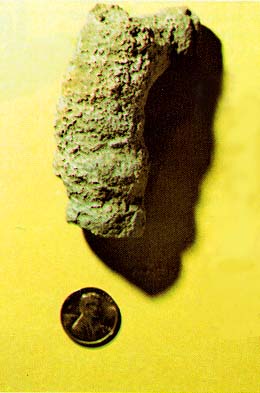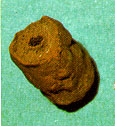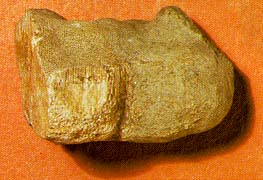
Ancient Life in Kansas Rocks, part 7 of 27
Heliospongia is a sponge although not bearing much resembleance to what most people them of when the word sponge is mentioned. Sponges belong to the phylum Porifera, meaning pore bearing. They are nearly exclusively marine and are quite simple organisms, but vary greatly in form and size. Some are solitary individuals, and others occur in groups or colonies of individuals. They lack internal organs and circulatory and digestive systems. External holes or pores in the walls provide openings through which water carries food and oxygen into the cells and a larger opening at the top (osculum) permits the water to flow out.

Snce all sponges live attached to the bottom, they must necessarily live in quite waters, because sediment in agitated water would tend to clog these openings and to injure the delicate tissue within the organism. In general, there are two kinds of cells in the sponge body: one that lines the internal cavity and which, by making motions with hair-like flagella, creates food-carrying water currents; and another that forms the outer part of the body wall and sometimes secretes skeletal structures of silica or calcium carbonate called spicules. The spicules are what give the sponge it ability to be preserved as a fossil.
The natural bath sponge is not commonly preserved as a fossil because it lacks hard spicules, but Heliospongia had a preservable skeleton. Heliospongia had lumpy siliceous spicules that interlocked to form its thick cylidrical wall. The pores were present along the outside of the cylinder, and the osculum at the upper end. (Hickory Creek Shale, Upper Pennsylvanian)

In this figure (slightly enlarged) are two pecularily-shaped fossils. These distinctive rows of bead-like spherical chambers are the calcareous skeletal remains of the sponge Girtyoceolia. The entire animal, of which only small parts are seen here, lived in shallow clear water, attached to the bottom. They branched upward from the base, and bore numerous spoutlike openings on the outer walls of the chambers through which water currents passed, bringing in food and oxygen and carrying away wastes. (Hickory Creek Shale, Upper Pennsylvanian)
In the photo below (slightly enlarged) is the sponge Amblysiphonella. It is similar in structure to Girtyocoelia, but differs in that the chambers are less bead-like or globular, and it has an axial tube seen as a circular aperture in the specimen.

This specimen is rust-colored because the original skeletal material has been replaced by an iron-rich mineral. Amblysiphonella is restricted to Upper Pennsylvanian rocks. (Topeka Limestone, Upper Pennsylvanian)
Chaetetes, shown in the photo below, is a sponge [classified as common colonial coral at time of publication] of southeastern Kansas. It's thin-walled polygonal tubes can be seen in this specimen. Classed among the tabulate [sponge], it commonly has platforms or tabulae within the tubes; these can be seen in the broken portion. (Pawnee Limestone, Middle Pennsylvanian)

Kansas Geological Survey
Placed online Feb. 1997
URL = "http://www.kgs.ku.edu/Publications/ancient/f07_sponges.html"
Send comments and/or suggestions to webadmin@kgs.ku.edu